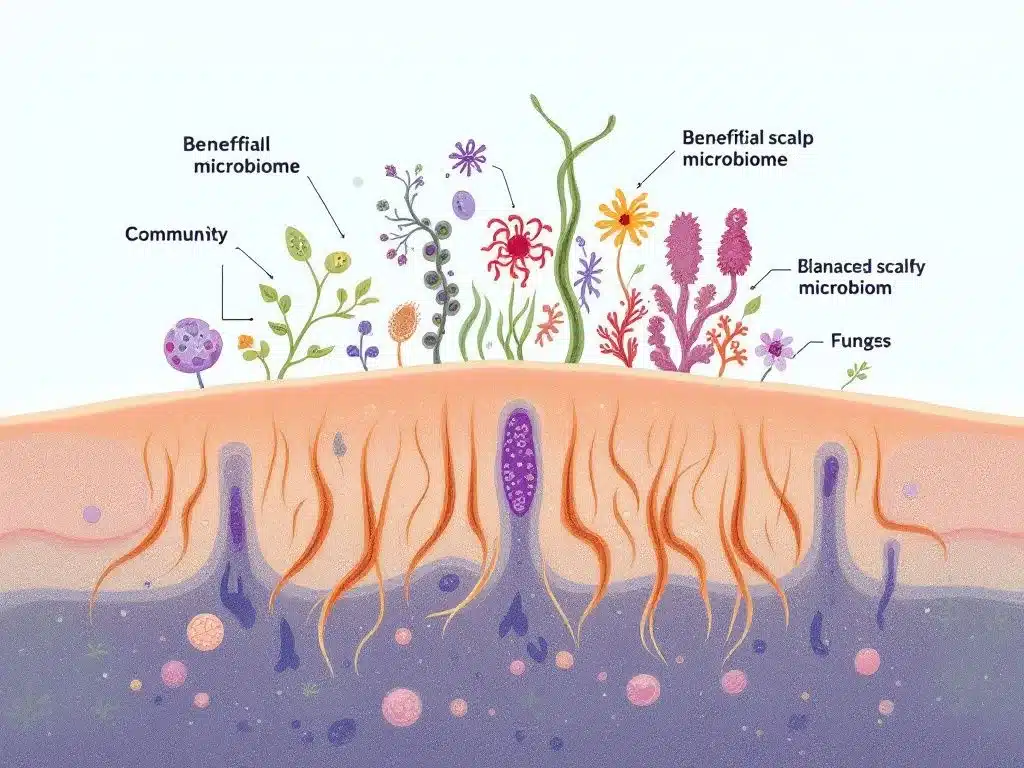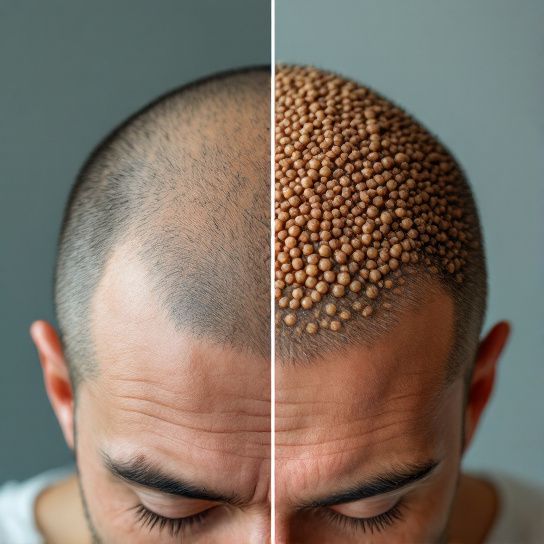
Hey there! So, you’ve probably pampered your hair with all sorts of shampoos, serums, and oils to keep it shining and strong, right? But what if I told you there’s an entire universe living right under those strands, and it’s critical to your hair health? Yeah, I’m talking about your *scalp microbiome*. Intrigued? You should be, because getting to grips with this topic can really change the game for your hair and scalp health.
What’s Lurking on Your Scalp: Meet the Microbiome
Now, before you start thinking about creepy crawlies, hold on just a sec. The microbiome refers to the amazing ecosystem of microorganisms living on your scalp. This includes bacteria, fungi, and even viruses. Hey, it’s crowded up there!
But here’s the kicker. Just like your gut, your scalp has a “balance” of these microorganisms, and striking the right balance is super important for keeping scalp issues like dandruff, itchiness, or even hair loss at bay. It’s not just about fighting bad guys; it’s more like nudging the good guys to do their job better.
The Yin and Yang of Scalp Health
You see, having some bacteria on your scalp isn’t a bad thing. In fact, it’s necessary. Beneficial bacteria (the good guys!) protect the scalp by preventing harmful microbes from taking over. Picture these good bacteria as tiny little soldiers, fortifying your scalp’s natural defense.
When there’s a balance, your hair is smooth, your scalp feels fresh, and early signs of baldness keep their distance. But when the balance tips? That’s when dryness, irritation, and other annoying issues start creeping in.
How’s Your Scalp Doing? Signs of a Misaligned Microbiome
How do you know if your scalp bacteria balance is off? Great question! Here are some **common symptoms** to look out for:

- Persistent Itching – Scratchy head despite using good products? It could be a microbial imbalance.
- Excessive Dandruff – Flakes all over? Your scalp may be signaling an overgrowth of certain bacteria or fungi.
- Oily or Dry Scalp – Too much sebum or not enough? Both extremes are signs that the ecosystem needs a tune-up.
- Unexplained Hair Loss – Shedding more hair than usual isn’t fun. Bacteria imbalance might be the sneaky culprit.
Feeling any of these? It’s time to befriend those scalp microbes.
The Science of a Healthy Scalp Microbiome
Let’s have a quick science chat, shall we? Your hair scalp microbiome is largely composed of species like _Cutibacterium acnes_ and _Staphylococcus epidermidis_. Before you start Googling these, know they all have key roles. The _Cutibacterium acnes_ helps keep the skin barrier robust and well-moisturized, while _Staphylococcus epidermidis_ helps fend off pathogens.
Just like climate changes affect ecosystems, things like product build-up, stress, or even diet can disrupt your scalp microbiome. You thought that last-minute fast food binge didn’t matter? Well… maybe it did!
DIY Detective Work: Assess Your Microbiome
It’s time to get to the bottom of things. Don’t worry, I’m not suggesting you need a microscope. Understanding your own scalp microbiome involves a few observations:
- Product Audit: Look at your shampoo and conditioner. Are you using something with harsh chemicals or sulfate-laden formulas? These can strip your scalp of natural oils and mess with bacteria balance.
- Lifestyle Check: Stressed much? Cortisol, aka the stress hormone, can make your scalp more oils or a bit barren—both disruptors of balance.
- Diet Diary: Poor diet can weaken your microbial shield. Nutritious foods high in omega-3s or probiotics potentially influence scalp health positively.
Making Peace with Your Micro-World
Alright, let’s talk solutions. Here are some actionable tips to boost your scalp microbiome and get it working in harmony:

1. Go Gentle on Products
Stick to gentle shampoos without harsh sulfates or parabens. Chemical-heavy products strip away beneficial oils and disturb the balance of the microbiome.
2. Embrace Probiotics
Yup, the same stuff that’s good for your gut is also great for the scalp! Foods rich in probiotics like yogurt, kimchi, and kombucha can be beneficial. Wonder if yogurt on your toast this morning did a scalp cleanse? Well, in a way… yes!
3. Apple Cider Vinegar Rinse
Give this a try! Mix a bit of apple cider vinegar with water and rinse your hair. The acidity helps create an unfavorable environment for bad bacteria while balancing the scalp’s pH.
4. Scalp Massage
Imagine this: a mini-vacation for your scalp. A good massage once in a while boosts blood circulation and helps nutrients reach your hair follicles easier.
5. Mind Your Stress
Easy to suggest, not so easy to do. But stress-reducing activities like yoga or just deep-breathing can have a huge impact. Your scalp and those tiny microbes will thank you.

6. Pay Attention to Your Diet
For some people, high sugar intake can upset microbial balance. Keep the diet rich in fruits, veggies, and healthy fats for optimal results.
Bonus Tidbit: Are Prebiotics a Thing?
Sure are! Prebiotics are an awesome complement to probiotics because they’re essentially food for the beneficial bacteria. Just imagine serving a healthy meal to the tiny defenders of your scalp fortress, encouraging them to proliferate even more.
When to Seek Professional Help
If you’re still facing issues after implementing these changes, it might be time to call in the pros. Dermatologists can assess scalp health and sometimes offer specialized treatments such as microbiome-restoring serums or light therapy.
Remember, everyone’s scalp is unique! Some may naturally have a microbiome that effortlessly maintains its balance with regular care. For others, this can be a complex dance requiring a few professional steps.
Riding the Long Haul with a Happy Microbiome
The scalp microbiome isn’t just a novel discovery in health and wellness—it’s becoming key to understanding and managing irreversible hair concerns. Sometimes the smallest contributors can make an immense impact. Give your scalp microbiome a little TLC and see the surprising changes unfold over weeks, not days. Patience is definitely a virtue here!
But no pressure, really. Just approach this as a space for improvement, not perfection. You’ve got this, my friend.
When you nurture this sub-visible universe, the wonders it can do for your luscious locks are nothing short of magic. If I were to leave you with one heartful piece of advice, it’s this: Listening to your scalp is just the beginning. You’ve now unlocked the door to vibrant, healthy hair from the inside out.
Frequently Asked Questions
What is the scalp microbiome?
The scalp microbiome refers to the trillions of microorganisms, including bacteria and fungi, that live on your scalp. These microscopic organisms play a crucial role in maintaining the health and vitality of your scalp and hair by breaking down sebum, regulating the immune system, and maintaining the scalp’s natural balance[1][2][3).
How does the scalp microbiome affect hair health?
A balanced scalp microbiome is essential for hair health. It helps break down sebum to release essential nutrients like fatty acids, regulates the scalp’s pH balance, protects against pathogens, reduces inflammation, and maintains the overall appearance and texture of the hair. An imbalance in the scalp microbiome can lead to conditions such as dandruff, seborrheic dermatitis, and hair loss[1][2][5).
What are the signs of an unbalanced scalp microbiome?
Signs of an unbalanced scalp microbiome include flaking skin, itching, irritation, and conditions like dandruff, seborrheic dermatitis, and tinea capitis. Severe imbalances can also lead to more serious scalp skin disorders and hair loss issues such as alopecia areata and scalp psoriasis[2][4][5).
How can I improve and maintain a healthy scalp microbiome?
To improve and maintain a healthy scalp microbiome, it is important to adopt a holistic approach to scalp care. This includes using gentle hair care products, maintaining good hygiene practices, avoiding harsh chemicals, and possibly incorporating treatments or lifestyle adjustments recommended by a trichologist. Products that rebalance excess sebum, increase hydration, and reduce scalp irritation without altering the scalp pH can also be beneficial[1][3][5).
References- Penny James Trichology Center. (2023). A Guide to Scalp Microbiome.
- The Secret Life of Skin. (2022). What is the scalp microbiome and why is it important for our health?.
- PMC. (n.d.). New Topicals to Support a Healthy Scalp While Preserving the Microbiome.
- PubMed. (2024). A guide to better understanding scalp diseases and treatments.



Leave a Reply